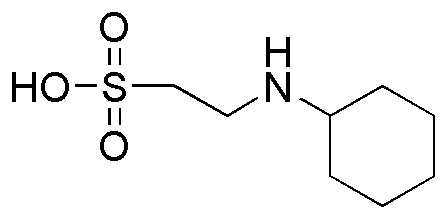2-(N-Cyclohexylamino)ethanesulfonic acid is widely utilized in research focused on:
- Biological Buffers: This compound is commonly used as a buffering agent in biological and biochemical research, helping to maintain stable pH levels in various experiments, which is crucial for enzyme activity and cellular functions.
- Pharmaceutical Formulations: It plays a significant role in the formulation of drugs, particularly in stabilizing active pharmaceutical ingredients and enhancing their solubility, making it valuable in the pharmaceutical industry.
- Cell Culture Media: The compound is often included in cell culture media to support the growth and maintenance of mammalian cells, providing essential nutrients and maintaining optimal conditions for research and development.
- Analytical Chemistry: It is used in analytical techniques such as chromatography and electrophoresis, aiding in the separation and analysis of biomolecules, which is essential for quality control in various industries.
- Environmental Studies: Researchers utilize this compound in environmental science to study the effects of pollutants and to develop methods for water treatment, contributing to sustainability efforts.
General Information
Properties
Safety and Regulations
Applications
2-(N-Cyclohexylamino)ethanesulfonic acid is widely utilized in research focused on:
- Biological Buffers: This compound is commonly used as a buffering agent in biological and biochemical research, helping to maintain stable pH levels in various experiments, which is crucial for enzyme activity and cellular functions.
- Pharmaceutical Formulations: It plays a significant role in the formulation of drugs, particularly in stabilizing active pharmaceutical ingredients and enhancing their solubility, making it valuable in the pharmaceutical industry.
- Cell Culture Media: The compound is often included in cell culture media to support the growth and maintenance of mammalian cells, providing essential nutrients and maintaining optimal conditions for research and development.
- Analytical Chemistry: It is used in analytical techniques such as chromatography and electrophoresis, aiding in the separation and analysis of biomolecules, which is essential for quality control in various industries.
- Environmental Studies: Researchers utilize this compound in environmental science to study the effects of pollutants and to develop methods for water treatment, contributing to sustainability efforts.
Documents
Safety Data Sheets (SDS)
The SDS provides comprehensive safety information on handling, storage, and disposal of the product.
Product Specification (PS)
The PS provides a comprehensive breakdown of the product’s properties, including chemical composition, physical state, purity, and storage requirements. It also details acceptable quality ranges and the product's intended applications.
Certificates of Analysis (COA)
Search for Certificates of Analysis (COA) by entering the products Lot Number. Lot and Batch Numbers can be found on a product’s label following the words ‘Lot’ or ‘Batch’.
Numéro de catalogue
Numéro de lot/série
Certificates Of Origin (COO)
This COO confirms the country where the product was manufactured, and also details the materials and components used in it and whether it is derived from natural, synthetic, or other specific sources. This certificate may be required for customs, trade, and regulatory compliance.
Numéro de catalogue
Numéro de lot/série
Safety Data Sheets (SDS)
The SDS provides comprehensive safety information on handling, storage, and disposal of the product.
DownloadProduct Specification (PS)
The PS provides a comprehensive breakdown of the product’s properties, including chemical composition, physical state, purity, and storage requirements. It also details acceptable quality ranges and the product's intended applications.
DownloadCertificates of Analysis (COA)
Search for Certificates of Analysis (COA) by entering the products Lot Number. Lot and Batch Numbers can be found on a product’s label following the words ‘Lot’ or ‘Batch’.
Numéro de catalogue
Numéro de lot/série
Certificates Of Origin (COO)
This COO confirms the country where the product was manufactured, and also details the materials and components used in it and whether it is derived from natural, synthetic, or other specific sources. This certificate may be required for customs, trade, and regulatory compliance.


